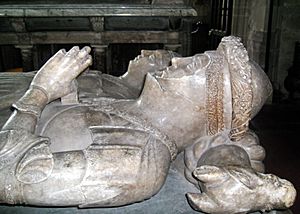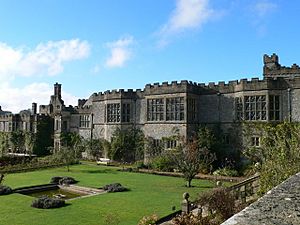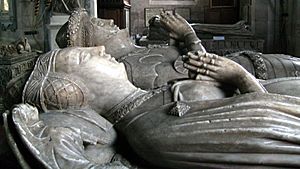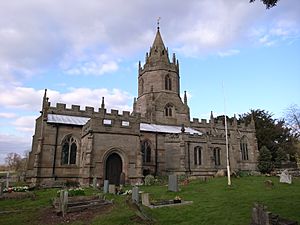Richard Vernon (speaker) facts for kids


Sir Richard Vernon (born around 1390 – died 1451) was an important English landowner. He was also a Member of Parliament (MP) and even became the Speaker of the House of Commons. This means he was a key leader in the English government during his time.
Contents
Who Was Sir Richard Vernon?
His Family and Early Life
Richard Vernon came from a well-known and wealthy family. They lived at Haddon Hall in Derbyshire, a large and impressive estate. His father, also named Richard de Vernon, passed away in 1400 when young Richard was only ten years old. This meant he didn't fully take over his family's lands until he was 21. Before that, he married Benedicta de Ludlow, who was from Tong, Shropshire.
What Lands Did Sir Richard Own?
A Wealthy Landowner
Sir Richard Vernon owned a lot of land in different parts of England and Wales. He inherited many properties from his parents. These included:
- In Cheshire: The right to manage Macclesfield Forest, and the areas of Marple and Wibersley.
- In Staffordshire: Estates near Draycott, Harlaston, and Pipe Ridware.
- In Derbyshire: Lands around Bakewell, Baslow, Calver, Haddon, Netherseal, and Rowsley.
- In Pembrokeshire (Wales): The areas of Stackpole Elidor, Bosherston, and Rudbaxton.
- In Carmarthenshire (Wales): The areas of Pendine and Cantrewyn.
- In Buckinghamshire: The areas of Pitchcott and Adstock, including the right to choose priests for their churches.
- In Westmorland: The areas of Meaburn Maulds and Newby, plus other scattered lands in Cumberland.
More Lands from His Grandmother
When his grandmother, Juliana de Pembrugge, passed away, Sir Richard gained even more land. These lands had belonged to her brother, Fulke de Pembrugge, who was also his wife's stepfather. These new lands included:
- In Shropshire: The manor of Tong and Tong Castle.
- In Leicestershire: The manor of Aylestone.
Tong Church and College
Sir Fulke's second wife, Isabel of Lingen (who was also Sir Richard's mother-in-law), had started a special religious college at Tong. It had a warden and four priests who would pray for the souls of her three husbands. She gave Sir Richard the right to choose the priests for this church. She also gave him her manor of Haselbech in Northamptonshire.
In 1415, King Henry V decided to close down all "alien priories." These were small religious houses in England that were connected to larger monasteries in France. One of these was Lapley Priory in Staffordshire. Its lands were given to Tong College. This made the college much richer and more stable. Tong Church became a very important place for the Vernon family, where many of them were later buried in grand tombs.
Sir Richard Vernon's Career in Government
Serving the King in France
In 1416, Sir Richard received money from the government to serve in France for a few months. This was likely during the time when England was fighting France. He might have been part of a small group of soldiers. It's thought he helped in the relief of Harfleur, a town where English soldiers were trapped after the famous Battle of Agincourt.
Becoming a Sheriff and Justice
After returning from France, Sir Richard quickly took on important roles in England.
- In November 1416, he became the High Sheriff of Staffordshire. A sheriff was like a chief law enforcement officer for a county.
- He was then made a knight and a Justice of the Peace for Staffordshire for five years. A Justice of the Peace helped keep law and order.
- He also helped settle a dispute between a religious leader and a landowner in Derbyshire.
- He was appointed Sheriff of Nottinghamshire and Derbyshire twice (in 1425 and 1426) and High Sheriff of Staffordshire again in 1427.
A Member of Parliament and Speaker
Sir Richard Vernon became a Member of Parliament (MP) for the first time in 1419, representing Staffordshire. MPs were chosen to speak for their areas in the English Parliament.
- In 1420, he was called to Westminster to discuss how to defend Normandy, a part of France that England controlled.
- He also lent money to the King, showing his support for the Crown.
- In 1422, King Henry V died, leaving a very young son, Henry VI, as the new king. Sir Richard represented Derbyshire in the first Parliament of Henry VI's reign.
- The next year, he became a manager of the Duchy of Lancaster's lands in Derbyshire.
In 1426, Sir Richard represented Derbyshire again and was chosen as the Speaker of the House of Commons. This was a very important position. That Parliament met in Leicester Castle and was nicknamed the "Parliament of Bats." This was because members were not allowed to carry swords due to fears of violence, so they carried clubs or "bats" instead.
During this time, there was a power struggle between the young king's relatives, Cardinal Beaufort and Humphrey, Duke of Gloucester. Sir Richard had connections with the Beaufort family, which might have helped him become Speaker. As Speaker, he was able to help himself too. He supported a request from a young nobleman, Ralph Neville, for more money, which benefited Sir Richard as he managed some of Neville's lands.
Challenges and Alliances
Sir Richard was involved in some problems during the 1433 elections in Derbyshire. There was a big argument between different landowners, and Sir Richard arrived with a large group of men to influence the election. This led to a property dispute and even a violent attack in a church. However, no clear solution was found, and within a few years, Sir Richard was back on good terms with some of the people he had argued with.
To stay powerful, Sir Richard often sought support from even more influential people. From 1430, he became closely linked with Humphrey Stafford, 1st Duke of Buckingham, who was a very powerful duke. In 1440, Sir Richard formally agreed to support Stafford with six mounted men, and in return, he received an annual payment. This alliance helped Sir Richard's career. Stafford protected him from complaints about his management of lands and helped him get important jobs in South Wales, where Sir Richard already had interests.
Roles in Wales and Calais
Sir Richard held several important positions in Wales:
- He was a deputy judge in South Wales from 1431 to about 1438.
- From 1440 to 1445, he was a traveling judge in the area of Brecon.
- By 1445, he was serving as a knight steward in the courts of the Lord High Constable and the Earl Marshal. These were also high-ranking positions held by his powerful allies, like Humphrey Stafford.
- In 1450, he was appointed Sheriff of Pembroke, Llanstephan, and St Clears for life.
- He also became the constable (manager) of Pembroke Castle and Tenby Castle and gained many other profitable management roles in the region.
Humphrey Stafford, the Duke of Buckingham, also helped Sir Richard get important jobs in Calais, a French port city controlled by England.
- In 1445, Sir Richard was appointed Treasurer of Calais.
- In 1446, he became the receiver and keeper of the Calais mint (where coins were made).
However, these jobs came with challenges. As treasurer, Sir Richard built up large debts. When he passed away in August 1451, these debts were passed on to his oldest surviving son, William, who also took over as treasurer. The Crown (the King's government) took some of their land as security, and it seems William struggled to pay off his father's debts.
Sir Richard Vernon's Family
Sir Richard Vernon married Benedicta (also known as Bennet) Ludlow. She was the daughter of Sir John Ludlow and Isabel de Lingen, who founded the college at Tong. Sir Richard and Benedicta had at least four sons and four daughters.
Their children included:
- Richard: He was supposed to inherit everything but passed away before his father.
- Sir William: He was the oldest son who survived and inherited his father's main lands, some of his jobs, and his debts.
- Fulke: He helped manage lands in Derbyshire and was a captain at a castle in Calais.
- John: He became the High Sheriff of Pembrokeshire.
- Elenor: She married Sir Richard Wheelock.
- Benedicta: She married Sir Thomas Charlton, who later became Speaker of the House of Commons.
- Elizabeth: She married John Vampage, who was the Attorney General. After he died, she married Sir John Stanley.
- Agnes: She married John Cockayne.
- Margaret: She married Richard Longueville.
- Ann: She married Sir John Bradbury.
- Isabel: She married John Stanley.



